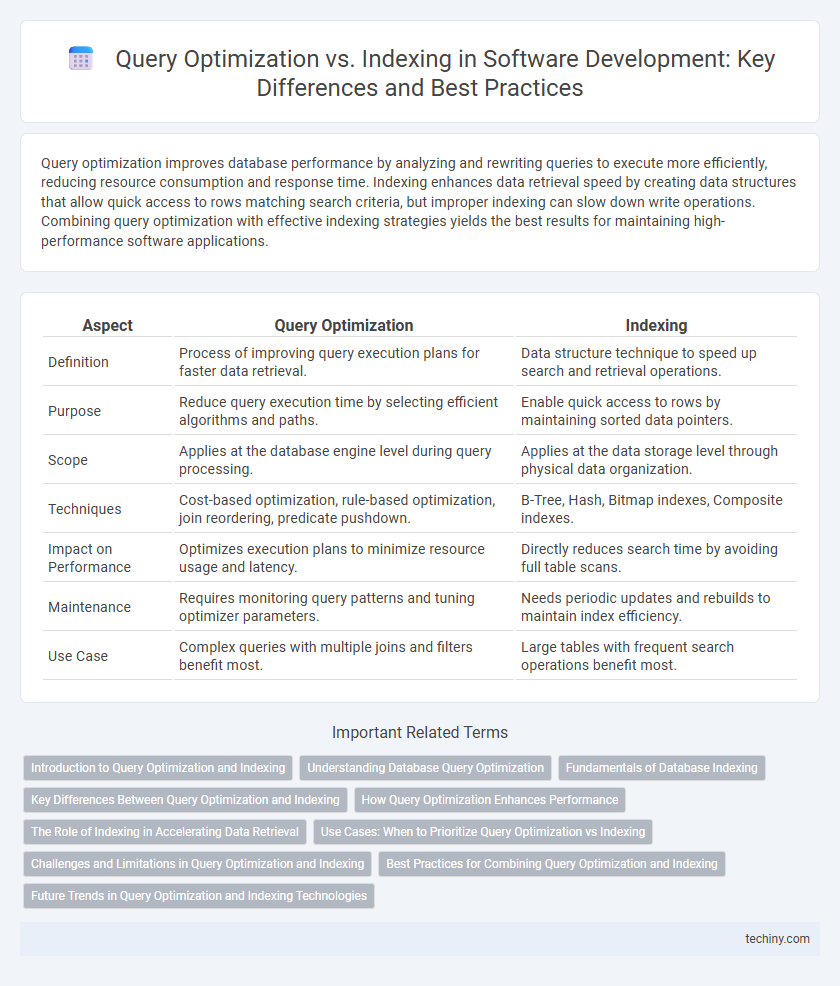Query optimization improves database performance by analyzing and rewriting queries to execute more efficiently, reducing resource consumption and response time. Indexing enhances data retrieval speed by creating data structures that allow quick access to rows matching search criteria, but improper indexing can slow down write operations. Combining query optimization with effective indexing strategies yields the best results for maintaining high-performance software applications.
Table of Comparison
| Aspect | Query Optimization | Indexing |
|---|---|---|
| Definition | Process of improving query execution plans for faster data retrieval. | Data structure technique to speed up search and retrieval operations. |
| Purpose | Reduce query execution time by selecting efficient algorithms and paths. | Enable quick access to rows by maintaining sorted data pointers. |
| Scope | Applies at the database engine level during query processing. | Applies at the data storage level through physical data organization. |
| Techniques | Cost-based optimization, rule-based optimization, join reordering, predicate pushdown. | B-Tree, Hash, Bitmap indexes, Composite indexes. |
| Impact on Performance | Optimizes execution plans to minimize resource usage and latency. | Directly reduces search time by avoiding full table scans. |
| Maintenance | Requires monitoring query patterns and tuning optimizer parameters. | Needs periodic updates and rebuilds to maintain index efficiency. |
| Use Case | Complex queries with multiple joins and filters benefit most. | Large tables with frequent search operations benefit most. |
Introduction to Query Optimization and Indexing
Query optimization enhances database performance by selecting the most efficient execution plan for retrieving data, reducing response time and resource consumption. Indexing creates data structures like B-trees or hash indexes to accelerate query processing by enabling rapid data lookup without scanning entire tables. Together, query optimization and indexing form essential components in database management systems to improve overall query efficiency and scalability.
Understanding Database Query Optimization
Database query optimization enhances performance by analyzing and restructuring SQL queries to reduce execution time and resource usage. Indexing accelerates data retrieval by creating data structures, such as B-trees or hash indexes, which allow the database engine to quickly locate rows without scanning entire tables. Efficient query optimization leverages indexing strategies alongside cost-based query planners to minimize I/O operations and improve overall database responsiveness.
Fundamentals of Database Indexing
Database indexing improves query performance by providing rapid access paths to data rather than scanning entire tables, significantly reducing search time and resource consumption. Indexes are built using data structures like B-trees or hash tables that organize data for efficient retrieval based on key values. Proper indexing strategies, considering query patterns and data distribution, play a critical role in optimizing complex SQL queries and enhancing overall database performance.
Key Differences Between Query Optimization and Indexing
Query optimization involves analyzing and restructuring database queries to improve execution efficiency, while indexing refers to creating data structures that enable faster data retrieval. Query optimization dynamically adjusts the query plan based on factors like join order and filter conditions, whereas indexing statically organizes data based on keys or columns to expedite lookups. Key differences include that query optimization focuses on the procedural aspect of accessing data, while indexing provides a physical mechanism to speed up these accesses.
How Query Optimization Enhances Performance
Query optimization improves software development performance by analyzing multiple execution plans and selecting the most efficient strategy to retrieve data, minimizing resource consumption and response time. It leverages statistics and cost estimates to rewrite queries, eliminating redundant operations and reducing database load. This process enhances scalability and throughput, especially in complex applications with large datasets and dynamic query patterns.
The Role of Indexing in Accelerating Data Retrieval
Indexing plays a crucial role in accelerating data retrieval by creating structured pathways to access database records efficiently, significantly reducing query response times. Unlike query optimization, which refines the execution plan, indexing directly affects how quickly the database engine locates and retrieves rows, especially in large datasets and complex queries. Well-designed indexes on key columns improve performance by minimizing full table scans and enhancing the speed of SELECT operations.
Use Cases: When to Prioritize Query Optimization vs Indexing
Query optimization is crucial when dealing with complex, ad-hoc queries or dynamic reporting where indexes may not cover all access patterns effectively. Indexing proves beneficial for frequently executed queries with predictable filtering or sorting criteria, dramatically improving read performance. Prioritize query optimization for workloads with diverse query patterns and indexing when stable, repetitive queries dominate database interactions.
Challenges and Limitations in Query Optimization and Indexing
Query optimization faces challenges such as high computational cost, inaccurate cost estimation, and difficulties in handling complex queries with multiple joins or subqueries. Indexing limitations include increased storage requirements, slower write operations due to index maintenance, and reduced effectiveness when queries involve non-indexed columns or range scans. Both techniques require careful balancing to enhance performance without introducing bottlenecks in dynamic or large-scale database environments.
Best Practices for Combining Query Optimization and Indexing
Combining query optimization and indexing requires a strategic approach to balance execution speed and resource usage by analyzing query patterns and selecting appropriate index types such as B-tree, hash, or composite indexes. Best practices include regularly updating statistics, avoiding excessive or redundant indexes, and using query execution plans to identify bottlenecks for targeted improvements. Leveraging parameterized queries and maintaining index health through periodic rebuilds or reorganizations enhances performance and scalability in complex database systems.
Future Trends in Query Optimization and Indexing Technologies
Emerging trends in query optimization emphasize machine learning algorithms that predict optimal execution plans by analyzing query patterns and data distribution. Advanced indexing technologies incorporate adaptive, multi-dimensional indexes that improve performance for complex queries on large, heterogeneous datasets. Integration of AI-driven self-tuning databases is set to revolutionize query optimization by dynamically adjusting indexes and query plans in real-time for evolving workloads.
Query Optimization vs Indexing Infographic

 techiny.com
techiny.com